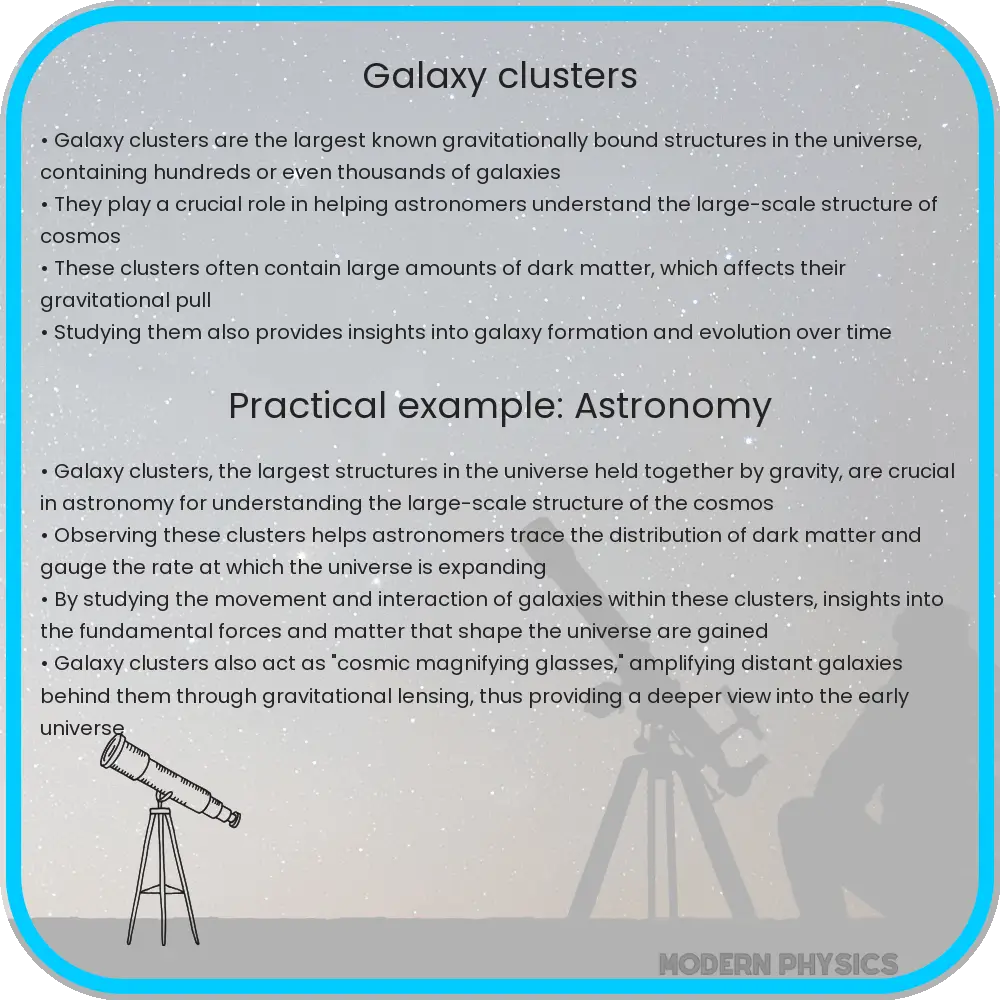Explore the formation, evolution, and dynamics of galaxy clusters, the largest structures in the Universe, and their role in cosmology and galaxy formation.

Galaxy Clusters: The Titans of the Universe
Galaxy clusters represent the largest structures in the Universe that are held together by gravity. These immense systems can contain hundreds to thousands of galaxies, hot gas, and dark matter. Understanding their formation, evolution, and dynamics provides critical insights into the cosmic web and the fundamental principles governing the universe.
Formation of Galaxy Clusters
Galaxy clusters form from the highest density peaks in the early universe’s matter distribution, primarily composed of dark matter. According to the standard model of cosmology, small fluctuations in the density of the universe expanded over time due to the gravitational pull of dark matter. These regions attracted more matter, growing larger and more massive, eventually leading to the formation of galaxy clusters. The process, known as hierarchical clustering, continues over billions of years, with smaller structures merging to form larger ones.
Evolution and Dynamics
The evolution of galaxy clusters is a dynamic process influenced by their massive gravitational fields. They are not static entities but are continuously growing by accreting nearby galaxies and galaxy groups. This accretion can lead to violent collisions and mergers, significantly affecting the cluster’s structure and the evolution of its member galaxies. For instance, when two clusters collide, they can create shock waves that heat the intracluster medium, increasing its X-ray emission.
Additionally, galaxy clusters are characterized by their hot intracluster medium (ICM). This is a diffuse, but extremely hot, gas that emits X-rays, providing evidence of the intense gravitational forces at play. The temperature and distribution of this gas offer vital clues about the cluster’s overall mass and the distribution of dark matter within it.
The dynamics within galaxy clusters are also governed by dark matter, which makes up about 85% of the total mass. The distribution of dark matter can be mapped through gravitational lensing, where the cluster’s gravitational field distorts the light from background galaxies. This effect provides invaluable information about the cluster’s mass distribution and the nature of dark matter.
Galaxy Cluster Interactions and Environmental Effects
Galaxy clusters are not isolated entities; their interactions with the environment and internal processes significantly influence galaxy evolution. As galaxies move through the intracluster medium, they experience ram pressure stripping, where gas is stripped away due to the pressure exerted by the ICM. This process can quench star formation in galaxies, leading to an evolution in their properties over time. Additionally, tidal forces within clusters can distort galaxies, leading to morphological transformations and triggering new star formation events in some cases.
Role in Cosmology and Galaxy Formation
Galaxy clusters play a pivotal role in cosmology and the study of galaxy formation. Their massive scale makes them sensitive to the cosmological parameters that shape the Universe, such as dark energy, dark matter, and the total amount of matter. By studying the distribution, temperature, and composition of the hot gas in clusters, astronomers can test models of cosmic evolution and understand the history and fate of the Universe.
Furthermore, the dense environments and extreme conditions found in galaxy clusters provide unique laboratories for studying galaxy formation and evolution. The processes that occur within clusters, such as galaxy mergers, star formation quenching, and active galactic nucleus feedback, offer critical insights into the life cycle of galaxies and the interplay between different cosmic components.
Conclusion
Galaxy clusters, with their rich structures and dynamics, are fundamental to our understanding of the Universe. They are the crossroads of astronomy, where galaxy evolution, cosmology, and dark matter research converge. By studying these colossal structures, astronomers can unravel the history of the cosmos, from the earliest fluctuations in the cosmic microwave background to the complex, large-scale structures we observe today. As observational techniques and theoretical models continue to improve, our understanding of galaxy clusters and their role in the cosmic tapestry will undoubtedly deepen, bringing us closer to unlocking the mysteries of the Universe.
